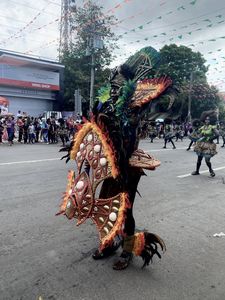Written by Brian Bernal, Hanks Realty Group Marketing Director
As a remote virtual assistant for Hanks Realty Group, I had the incredible opportunity to immerse myself in the rich cultural tapestry of the Philippines by attending two of its most vibrant festivals: the Sinulog Festival in Kabankalan City and the Dinagsa Festival in Cadiz City. These festivals are not just mere celebrations; they are windows into the soul of the Filipino people, showcasing their pagan past, their journey towards Christianity, and their unwavering spirit of unity and festivity.
The Sinulog Festival – Kabankalan City


The Sinulog Festival, held annually in Kabankalan City, is a spectacle of color, music, and dance. Rooted in the country’s pagan past, the festival’s name is derived from the Cebuano word “sulog,” which means “like water current movement.” It symbolizes the dance ritual performed by locals, which tells the story of the Filipino people’s acceptance of Christianity.
I had the privilege of witnessing the Sinulog dance firsthand, as performers adorned in vibrant costumes moved gracefully to the beat of drums and native instruments. Each step seemed to echo the resilience and faith of the Filipino people, a testament to their cultural heritage and enduring spirit.
Exploring the Cultural Significance
Beyond the captivating performances, I delved deeper into the cultural significance of the Sinulog Festival. I learned about its origins, tracing back to the arrival of the Santo Niño (Child Jesus) statue in Cebu during the early days of Spanish colonization. The festival’s fusion of pagan rituals and Christian traditions reflects the Philippines’ complex history and the synthesis of diverse cultures.
The Dinagsa Festival – Cadiz City

From Kabankalan City, I journeyed to Cadiz City to experience the Dinagsa Festival, another captivating celebration deeply rooted in local folklore. The word “dagsa,” meaning driftage, perfectly encapsulates the essence of this festival, which commemorates the arrival of settlers on the shores of Cadiz City.
The Dinagsa Festival is a feast for the senses, with vibrant street parades, elaborate costumes, and pulsating music filling the air.
I was swept away by the energy and enthusiasm of the performers, who brought to life the stories of their ancestors through dance and music.
One of the highlights of my experience at the Dinagsa Festival was witnessing the reenactment of ancient rituals performed by indigenous tribes. From traditional blessings to ceremonial offerings, every aspect of the festival was steeped in tradition and symbolism, providing a glimpse into the spiritual beliefs of the Filipino people.
I also had the opportunity to participate in hands-on activities, such as traditional crafts and cooking demonstrations, where I learned about the local customs and culinary delights of Cadiz City. It was a truly immersive experience that allowed me to connect with the community on a deeper level.
Reflections on Unity and Diversity
As I reflect on my journey through the Sinulog and Dinagsa Festivals, I am struck by the profound sense of unity and diversity that permeates Filipino culture. Despite centuries of colonization and adversity, the Filipino people have remained resilient, preserving their traditions and heritage with pride.
Through festivals like Sinulog and Dinagsa, they celebrate not only their past but also their future, embracing cultural diversity and fostering unity among different communities. It is a reminder that, despite our differences, we are all connected by a shared humanity and a collective desire to celebrate life’s joys.
My experience at the Sinulog and Dinagsa Festivals has been nothing short of transformative. From witnessing ancient rituals to dancing in the streets alongside locals, I have gained a newfound appreciation for the rich cultural tapestry of the Philippines.
These festivals are more than just colorful celebrations; they are living expressions of the Filipino spirit, embodying resilience, unity, and a deep-rooted sense of identity. As I bid farewell to Kabankalan City and Cadiz City, I carry with me the memories of their vibrant festivities and the enduring warmth of their people.

